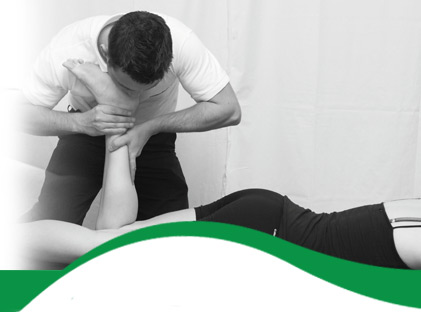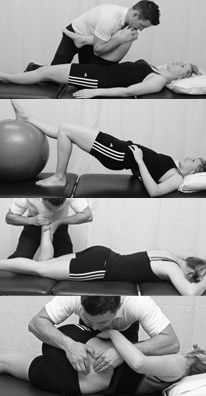Seven Hills Physiotherapy Case Studies
Please visit as often as you can to see how our Sheffield physios have helped and cured a vast array of problems for people from all walks of life. Click on each green headline below to reveal the body chart and story. If you think we might be able to help you why not contact us for some advice. If you think you know somebody who has a similar problem to one of our previous cases then why not share it with them on facebook or twitter.
Football goalkeeper enjoys significant relief following 3 years of repetitive tightening through the left side of his body.
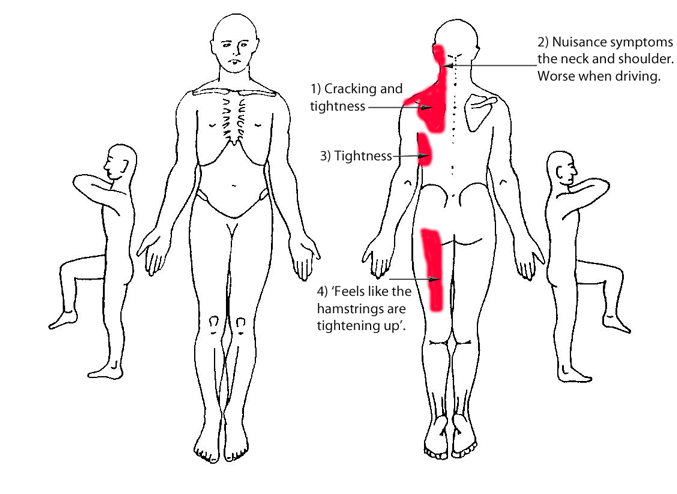
This gentleman attended physiotherapy complaining of repetitive tightening throughout the left side of his body. It had been problematic for around 3 years. Previous physiotherapy had helped but it always returned after a couple of months.
The tightening and cracking affected his football and he felt as though he constantly needed to stretch. Driving medium to long distances was particularly uncomfortable.
An in depth assessment and examination reassured the patient his shoulder and neck were actually fine. The cause of the problem stemmed from an area of spinal stiffness between the shoulder blades. As well as slightly left of centre into the joints that connect the ribs with the spine. As a result, the movement of the the nervous system was restricted and causing the muscles to tighten. The leg pain was simply due to a sciatic nerve restriction due to the movement problems higher up in the spine and ribs.
Physiotherapy consisted of 5 treatment sessions to loosen the spine through mobilisation and manipulation to the spine and ribs. Specific nerve exercises were provided to improve movement of the nervous system. The muscle tension was relieved by deep sports massage.
The spinal vertebrae are now moving within normal limits for a male in his mid-twenties. Consequently, the nervous system is able to move freely so the muscles are now not tightening around it. Hence, the feeling of tightness has significantly reduced. He is aware he will need to continue to maintain free movement of his spine and nervous system in order to prevent recurrence. A specific spinal and nerve exercise routine has been provided. Driving and playing as a football goalkeeper are both significantly easier and more comfortable.
Talented ladies footballer makes strides towards returning to action after 2 years.
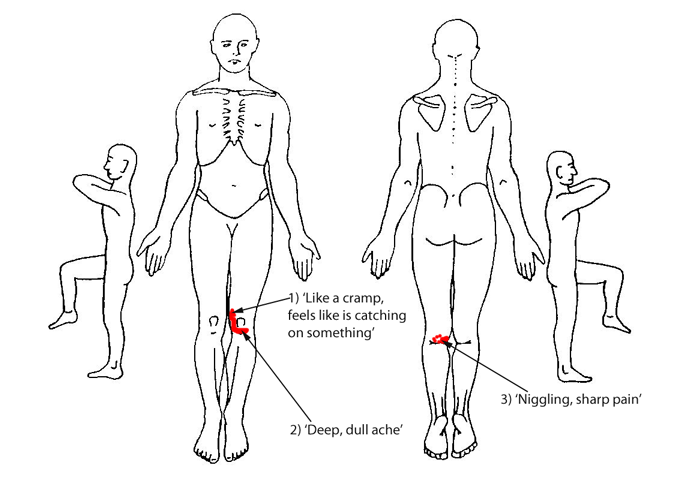 This lady was an interesting case and was managed differently to the hands-on therapy described in most other case studies. She suffered a torn meniscus (cartilage) in her knee over 2 years ago. Two operations later she was still frustrated as she wasn't any closer to returning to football. Her orthopaedic surgeon was confident the knee meniscus had been resolved and no further surgery was required.
This lady was an interesting case and was managed differently to the hands-on therapy described in most other case studies. She suffered a torn meniscus (cartilage) in her knee over 2 years ago. Two operations later she was still frustrated as she wasn't any closer to returning to football. Her orthopaedic surgeon was confident the knee meniscus had been resolved and no further surgery was required.
She was adamant there was a problem in the knee and couldn't understand how such perceived disability could be caused without there being a problem. A knee examination identified a pretty healthy knee and one which supported the surgeons views of no internal damage. There was minor joint stiffness and moderate weakness but nothing that added up to the level of disability. Due to the previous intensity of pain and the length of time she had suffered the brain and spinal cord had become overly sensitive and causing the knee to be sensitive on any type of activity.
When we first met she was unable to tolerate even standing for any period of time. Physiotherapy consisted of gradual exposure to exercise and activity (hardening) as well as muscle strengthening and acupuncture. Problems 2 and 3 resolved. Although 1 still remains she is able to do much more activity, even completing a weeks long UEFA football coaching course. This would have been impossible only a few months ago. However, she still has a way to go but has all the tools to push forward in her own time with the knowledge our team are always on the end of the phone for advice.
Rugby player passed fit for return to action after long-standing back pain is cured!
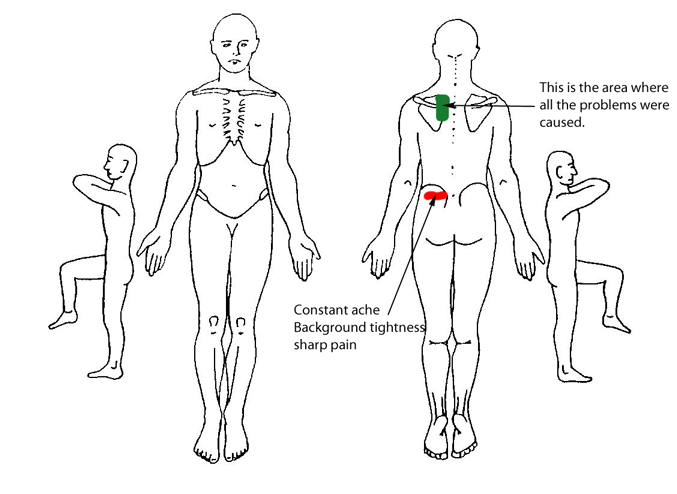 A keen amateur rugby player sought our advice following the onset of the symptoms marked in red above. This was preventing him from playing rugby and also participating in gym sessions. In addition, his work as a farmer was becoming extremely uncomfortable. The pain was caused by bending forwards in standing and also when he stretched his leg out in sitting i.e to pull his socks up. This immediately pointed to a nerve restriction and sure enough stressing the nervous system at the neck in these functional positions made the red symptoms worse. Examination of the nervous system showed marked reduction in movement on the left in comparison to the right.
A keen amateur rugby player sought our advice following the onset of the symptoms marked in red above. This was preventing him from playing rugby and also participating in gym sessions. In addition, his work as a farmer was becoming extremely uncomfortable. The pain was caused by bending forwards in standing and also when he stretched his leg out in sitting i.e to pull his socks up. This immediately pointed to a nerve restriction and sure enough stressing the nervous system at the neck in these functional positions made the red symptoms worse. Examination of the nervous system showed marked reduction in movement on the left in comparison to the right.
The logical place to look would be the lower back where the sciatic nerve exits the spinal cord. However, a very in depth look had me scratching my head. Nothing could be found. I remembered him saying he had suffered rib fractures playing rugby some years ago. Investigating this area (the area in green above) showed up all sorts of movement problems. Manipulation of this area of the spine and into the ribs immediately improved his ability to pull his socks up. He was also able to increase his bending forward from his knees to his shins. Subsequent sessions continued to mobilise this area and work on nerve mobility. He regained full movement of the green area of the spine and the nervous system moved equally on both sides. As a result the red pain resolved and he was able to return to the gym and rugby with no problems.
Severe headaches and sinus pains cured by physiotherapy!
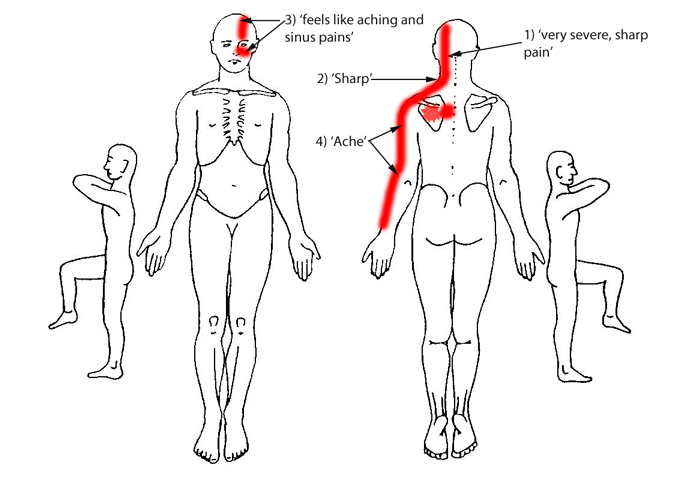 This lady attended physiotherapy as she had suffered headaches under the back of her skull and over the top of her head into her forehead and sinus area. This had been a problem for over 3 years and because she had left it other problems had started to appear around her shoulder blade and down into her arm. These symptoms were made worse by inactivity. Her job involved either sitting at her desk or driving long distances, therefore causing problems at work. The sinus pain was particularly unpleasant and made her feel as though she was ill.
This lady attended physiotherapy as she had suffered headaches under the back of her skull and over the top of her head into her forehead and sinus area. This had been a problem for over 3 years and because she had left it other problems had started to appear around her shoulder blade and down into her arm. These symptoms were made worse by inactivity. Her job involved either sitting at her desk or driving long distances, therefore causing problems at work. The sinus pain was particularly unpleasant and made her feel as though she was ill.
Did you know? Your neck can cause headaches and symptoms into the face. This was apparent with this lady. She had an extremely stiff neck through years of disuse as she feared too much neck movement would cause the problem. This belief was indeed incorrect and it was the lack of movement that was causing the problem. The joints at the top of the neck known as O/C1 (under the ridge of the skull) and and C2 were extremely stiff. By moving these joints the headaches and sinus pain was produced. We treaded carefully at first and built up the intensity of the treatment session by session. The arm and shoulder pain was caused by a stiff thoracic spine and ribs around the left shoulder blade area.This was treated by hands on therapy and home exercise and resolved very quickly. The neck pain took 5 sessions of mobilisation and manipulation but had fully resolved after 3 years of misery. Headaches don't have to be due to medical causes and are often caused by stiffness in the neck. If you or somebody you know suffers headaches please drop us a line or share this article. It may well be you don't have to live with it.
54 years old lady thought nothing could be done to help her neck pain and stiffness- thankfully she quickly realised it could!
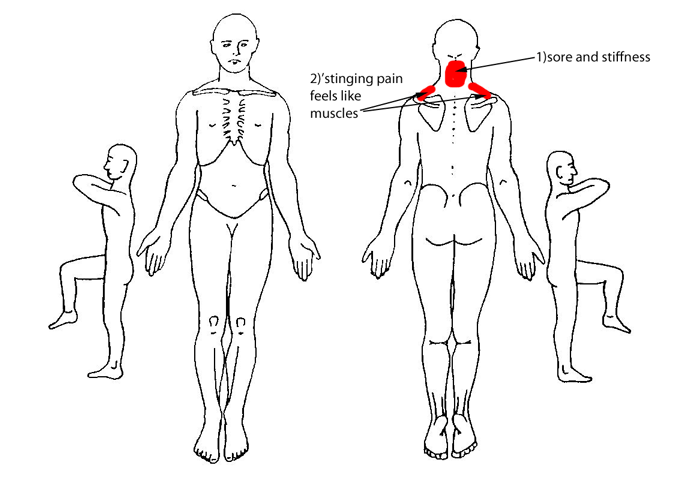 This lady attended physiotherapy on the recommendation of her husband who had enjoyed several succesful results with Seven Hills Physiotherapy in the past. She was sceptical at first and admitted she was not confident anything could be done as she had suffered for years. This belief travels through society and there are hundreds of thousands of people who have a problem that could be cured much easier than they may think.
This lady attended physiotherapy on the recommendation of her husband who had enjoyed several succesful results with Seven Hills Physiotherapy in the past. She was sceptical at first and admitted she was not confident anything could be done as she had suffered for years. This belief travels through society and there are hundreds of thousands of people who have a problem that could be cured much easier than they may think.
She explained her main problems were 1 and 2 above and were particularly problematic in the morning. Each morning her neck was extremely stiff and it took a while to get going. She had tried different pillows but nothing seemed to help.
Her neck was examined in detail and it was discovered she had two particularly stiff vertebrae in the upper part of her neck. The muscles had also tightened due to a loss of movement in her neck. It was explained that it was likely she had arthritis in her neck but 1 and 2 were being caused by stiffness and tightness NOT arthritis. The arthritis was simply causing the stiffness and tightness.
She agreed to hands on therapy with a home exercise programme. The improvements were evident after 3 minutes of mobilisation. It took 3 visits to completely clear the symptoms. She has been advised to continue the exercises at home about 3 times per week and this should keep the problem at bay for a long time. Her only regret was that she should have come years ago. Do you have or know anybody who may have a problem like this? If so please share this with them.
'Dead, useless' arm for 6 months brought back to life by physiotherapy in just 7 weeks!
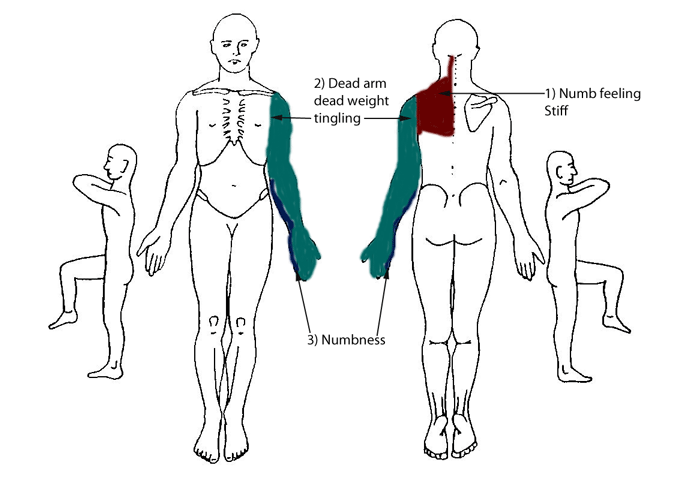
This lady attended physiotherapy extremely miserable and with a belief that she would never get better. She had suffered a car accident 6 months ago and had not had proper use of ler left arm since. She reported the bulk of it as feeling like a dead arm and dead weight with tingling. She also reported a complete loss of sensation in her little finger and up the inside of her forearm. She was having disturbed sleep each night and was constantly dropping objects due to the loss of sensation.
This symptom pattern, although widespread, is well understood. We examined the clinical health of the nerves and as expected the nerves were conducting normal impulses.
The neck moved relatively well but the thoracic spine (mid-spine) was extremely limited in movement. The cause of the problem was quickly linked to 3 small joints in the thoracic spine around the top of the left shoulder blade (T1-T3). Examination of these joints immediately reproduced the arm numbness and dead arm feeling. She also complained of fuzzyness after the spinal examination.
Treatment consisted of regaining the full function of the thoracic spine and gradually desensitising the T1-T3 spinal vertebrae. It took 3 sessions to make a noticeable improvement due to the duration of the problem. However, by 6 treatment sessions the arm symptoms had fully resolved, the grip returned so she was now able to safely carry and hold objects and sleep became undisturbed. She had full function of the spine and T1-T3 moved through full range. The only symptom remaining was a mild ache around area 1 after a full day at work. This is expected to fully resolve in the coming weeks. It was nice to see her smiling after she had originally felt her arm would never be the same again.
Teacher enjoys first full nights sleep in months following physiotherapy!
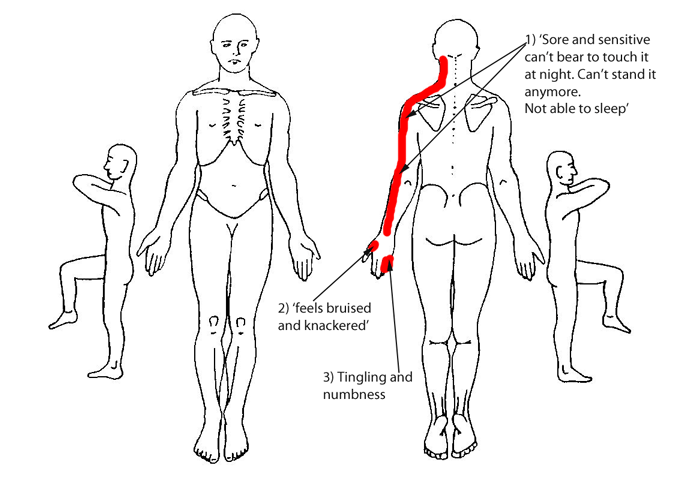 This 33 years old teacher attended physiotherapy desperate for a good nights sleep. She had suffered neck pain for years but over the last few months had started with arm pain. This was especially worse at night and she could not bear to touch it or even have bed covers resting on it. She was surprised it was not so bad during the day. Did you know? Pain caused by neural tissue is often worse at night as oxygen to the nerve is reduced as your blood pressure drops. Her fingers felt numb and tingled which are also features of damaged nerve tissue. She described her thumb as 'knackered' as she was unable to grip objects due to the pain.
This 33 years old teacher attended physiotherapy desperate for a good nights sleep. She had suffered neck pain for years but over the last few months had started with arm pain. This was especially worse at night and she could not bear to touch it or even have bed covers resting on it. She was surprised it was not so bad during the day. Did you know? Pain caused by neural tissue is often worse at night as oxygen to the nerve is reduced as your blood pressure drops. Her fingers felt numb and tingled which are also features of damaged nerve tissue. She described her thumb as 'knackered' as she was unable to grip objects due to the pain.
With these findings it was important to check the health of her peripheral nervous system. Reflexes were normal and although sensation was hypersensitive this did not indicate a conduction problem. Her neck, where the peripheral nerves originate, moved surprisingly well and there wasn't any stiffness. The main problems were stiffness in the mid part of her spine, T4-T6, located between the shoulder blades. The mobility of her entire nervous system was extremely poor for a lady of her age.
Physiotherapy aimed to improve movement of the nervous system by improving flexibility at T4-T6 and providing functional nerve gliding treatments. After 2 sessions and 3 weeks she returned complaining of no sleep disturbances and feeling much healthier and energised as a result. Treatment was progressed and 1 session and 2 weeks later she was not suffering any arm pain and only feeling a mild background ache in her back and neck. This was a good result considering how bad she had been previously and the number of years she had suffered neck pain. She discharged herself at this point happy with the outcome.
Do parts of your body cause you pain, ache, feel stiff, or seem weak or unstable?
Do parts of your body cause you pins and needles, tingling, burning, or feel numb?
Do any of these complaints prevent your body from moving or working how it should?
Do any of these complaints disturb your sleep or make it difficult to relax?
Do any of these complaints or loss of movement in your body mean there are things in your life that you struggle to do or can’t do at present?
Do you feel your life would be more comfortable and enjoyable if somebody could help you with these complaints?
If you answered YES to any, or all, of these questions then the Seven Hills Physiotherapy team are here to help. We will take great interest in listening to YOUR problems so we can find out how YOU would like us to help YOU lead a more comfortable and enjoyable life.



